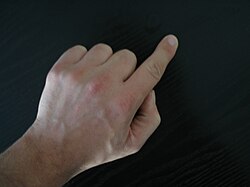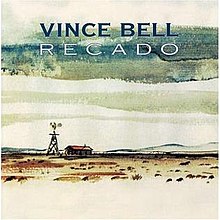집게손가락
Index finger| 집게손가락 | |
|---|---|
 검지를 펴고 왼손을 잡습니다. | |
| 세부 사항 | |
| 동맥 | 집게손가락 요골동맥, 적절한 손바닥 디지털 동맥, 배측 디지털 동맥 |
| 정맥 | 팔마 디지털 정맥, 배면 디지털 정맥 |
| 신경 | 요골 신경의 배측 디지털 신경, 정중 신경의 적절한 장골 디지털 신경 |
| 식별자 | |
| 라틴어 | 디지터스 II 원고, 디지터스 세컨더스 원고, 색인 |
| TA98 | A01.1.00.054 |
| TA2 | 152 |
| FMA | 24946 |
| 해부학 용어 | |
집게손가락(집게손가락,[1] [2]첫째손가락, 집게손가락, 트리거손가락, 디지터스세컨더스, 디지터스II 등)은 사람의 손의 두 번째 자리다.그것은 엄지와 가운데 손가락 사이에 있다.이것은 보통 가장 능숙하고 민감한 손의 숫자이지만 가장 길지는 않다.가운데 손가락보다 짧고 약지보다 짧거나 길 수 있습니다(자리 비율 참조).
해부학
"검지"는 문자 그대로 "지시하는 손가락"을 의미하며, 해부학적 이름은 "검지"와 "두 번째 숫자"입니다.
집게손가락에는 세 개의 지골이 있다.근육은 없지만 뼈에 힘줄이 붙어 손의 근육에 의해 조절된다.
사용하다
세로로 잡은 하나의 검지는 숫자 1을 나타내기 위해 종종 사용되거나(그러나 손가락 수는 문화에 따라 다르다), 또는 손가락을 들거나 옆으로 움직일 때, 그것은 경고적인 제스처가 될 수 있다.손바닥을 내밀고 엄지손가락과 가운뎃손가락이 닿으면 미국 수화 알파벳의 문자 d를 나타낸다.
포인팅
손가락으로 가리키는 것은 항목, 사람, 장소 또는 [3]대상을 표시하거나 식별하는 데 사용할 수 있습니다.
한 살 무렵 아기들은 관심, 욕망, 정보를 포함한 비교적 복잡한 생각을 전달하기 시작합니다.인간의 아기들을 가리키는 것은 정신의 이론이나 다른 사람들의 생각을 이해하는 능력을 보여줄 수 있다.이 제스처는 인간 언어 발달의 하나의 기초를 형성할 수 있다.
인간이 아닌 영장류들은, 다른 사람들이 생각하는 것에 대한 생각을 형성하는 능력이 부족하기 때문에, 훨씬 덜 복잡한 방법으로 [4]포인팅을 사용합니다.그러나 까마귀, 개[5], 코끼리는[6] 손가락질을 이해한다.
일부 문화권, 특히 동남아시아의 말레이시아인과[7] 자바인에서는 검지를 사용하는 것은 무례한 것으로 여겨지기 때문에 엄지손가락을 대신 사용한다.
이슬람의 집게손가락
이슬람에서 집게손가락을 드는 것은 신의 불가분의 일체성을 나타내는 타와드(تTawh (d)를 의미한다.그것은 신의 단결을 표현하기 위해 사용된다.[citation needed]
In Arabic, the index or fore finger is called musabbiḥa (مُسَبِّحة), mostly used with the definite article: al-musabbiḥa (الْمُسَبِّحة).때때로 as-sabbaraa([8][9]사바사바사)도 사용된다.검지를 뜻하는 아랍어 단어와 같은 어원을 공유하는 아랍어 동사 بََّ - means means means means는 다음과 같이 말하며 신을 찬양하거나 찬양하는 것을 의미한다.
미술에서의 제스처
예술적 관례로서, 시청자를 가리키는 검지는 명령이나 호출의 형태이다.이것의 두 가지 유명한 예는 영국과 미국이 제1차 세계대전 때 사용한 모집 포스터이다.
집게손가락이 위를 가리키는 것은 교권의 표시이다.이것은 라파엘의 [10]아테네 유파에서 플라톤의 묘사에 나타나 있다.
 아담의 창조, 미켈란젤로, 1512년의 세부사항 |
「 」를 참조해 주세요.
레퍼런스
- ^ "forefinger - definition of forefinger in English Oxford Dictionaries". Oxford Dictionaries English. Retrieved 2017-06-08.
- ^ "first finger - definition of first finger in English Oxford Dictionaries". Oxford Dictionaries English. Retrieved 2017-06-08.
- ^ Gary Imai. "Gestures: Body Language and Nonverbal Communication" (PDF). Archived from the original (PDF) on March 31, 2010. Retrieved 12 November 2009.
- ^ Day, Nicholas (26 March 2013). "Research on babies and pointing reveals the action's importance". Slate. Retrieved 25 April 2013.
- ^ Kirchhofer, Katharina C.; Zimmermann, Felizitas; Kaminski, Juliane; Tomasello, Michael (2012). "Dogs (Canis familiaris), but Not Chimpanzees (Pan troglodytes), Understand Imperative Pointing". PLOS ONE. 7 (2): e30913. Bibcode:2012PLoSO...730913K. doi:10.1371/journal.pone.0030913. PMC 3275610. PMID 22347411.
- "Dogs succeed while chimps fail at following finger pointing: Chimpanzees have difficulty identifying object of interest based on gestures". ScienceDaily (Press release). February 8, 2012.
- ^ Goodman, M.; Sterner, K. N.; Islam, M.; Uddin, M.; Sherwood, C. C.; Hof, P. R.; Hou, Z. C.; Lipovich, L.; Jia, H.; Grossman, L. I.; Wildman, D. E. (2009). "Phylogenomic analyses reveal convergent patterns of adaptive evolution in elephant and human ancestries". Proceedings of the National Academy of Sciences. 106 (49): 20824–9. Bibcode:2009PNAS..10620824G. doi:10.1073/pnas.0911239106. JSTOR 40536081. PMC 2791620. PMID 19926857.
- Katie Collins (October 10, 2013). "Elephants found to understand human pointing without training". Wired UK.
- ^ Scott, David Clark (12 April 1990). "A Thumb Points the Way in Java". The Christian Science Monitor.
...figures in some reliefs can be seen pointing - with their thumbs. "Pointing with the index finger is a terrible thing to do. It means death or violence. People used their thumb for polite pointing and it's still the same today, notes Jan Fontein, curator of the exhibition of ancient Indonesian sculpture sponsored by Mobil Indonesia...
- ^ Drißner, Gerald (2016). Islam for Nerds - 500 Questions and Answers. Berlin: createspace. p. 521. ISBN 978-1530860180.
- ^ "What does it mean when a Muslim raises the index-finger?". Arabic for Nerds. 2016-12-31. Retrieved 2019-07-18.
- ^ Brusati, Celeste; Enenkel, Karl A. E.; Melion, Walter (Nov 11, 2011). The Authority of the Word: Reflecting on Image and Text in Northern Europe, 1400-1700. Brill. p. 168. ISBN 978-9004215153.
외부 링크
![]() Wikimedia Commons의 집게손가락 관련 미디어
Wikimedia Commons의 집게손가락 관련 미디어







